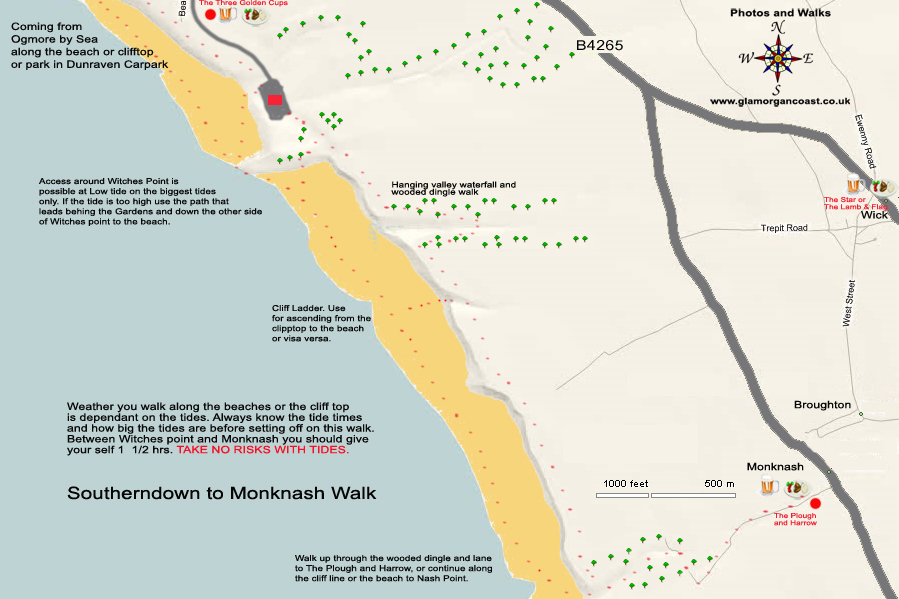 |
|
Walk and Map for Southerndown Bay Three Golden Cups, Dunraven Bay to Monknash Beach & Plough and Harrow Pub. ( Right Click the Map to save it and print it ). |
 |
|
Dunraven Bay Parking Charge From 1st May to 30th September 9.00am to 5.00pm 1 min to 8 Hours £3.00 1st October to April 30th £1 all day. -------------------- Parking at the Plough and Harrow pub Monknash is Free. However, when Parking at Monknash Farm closer to the Dingle there is a£1.50 courtesy payment box. |
|
Local Links Plan ahead be safe Accomadation |
|
The Wreckers of Wick along these cliffs. The coastline to the south and west of Wick is formed of rocks of the Lower Lias series that display horizontal stratification and are fossil bearing. It is from the top of these cliffs that, according to local folklore, the 'Wreckers of Wick' would, in the times before modern navigation, lure ships onto the rocks by showing false lights and then plunder the cargo. It is recorded that the bodies of drowned sailors were recovered from the beaches by Monks from the monastic grange at nearby Monknash and taken to what is now the Plough & Harrow Inn where they were prepared for burial. Historically this stretch of coastline has one of the highest instances of shipwrecks in Wales, its exposure to the Atlantic swell, south-westerly winds and shallow reefs making it treacherous to shipping. More recently the coastline has become popular for surfing and fishing. The parish church of Wick is dedicated to Saint James the Great, and like many of the other churches in the parish dates from the twelfth century. It began as a chapel, but was later gifted to Ewenny Priory. It is a Grade 2* listed building and consists of a chancel, nave, south porch and western 'saddle back' tower. The church is built in the Early English Period style, although the oldest parts of the structure such as the chancel arch, the south door and a small window in the chancel, all date from the 12th century. The church has a medieval stone mensa (rectangular) altar, views of which are provided through the 'squints' (hagioscopes) from the nave. The altar has unusual niches on either side, which probably contained statues of St James and the Blessed Virgin in centuries past. St James' was the subject of a major Victorian restoration 125 years ago and further additions have been made since then. The registers date from 1813. Wick also has a Unitarian and General Baptist Chapel that has held regular services since 1792. Approximately 1 mile to the west of the village is Monks Wood, a 10 acre plantation of mixed native woodland species managed by the Woodland Trust and the Monks Wood Committee. The wood was planted with native broadleaved trees and shrubs by villagers from Wick in November 2000. A wide mown path follows a circular route through the site and there is an information display for visitors. Another area of ecological importance is Clemenstone Meadows, directly to the north of the village, comprising 2 traditionally managed meadows on either side of a brook that support a number of rare plant species. The village was the birthplace of Sir Keith Thomas in 1933 and is now home to the family of the Olympic gold medallist and World Champion cyclist Nicole Cooke. Sports clubs in the village include Wick Rugby union Club and the Wick & District Cricket Club. On November 28 2006, the village of Wick became the first community in the UK to be switched over to British Telecom's "21st Century Network" (21CN); an advanced high-speed broadband network that will be rolled out throughout the UK over the coming years, replacing all of BT's existing networks. Laura Wess, 11, made the first call using the system from Wick and Marcross Primary School to the Right Reverend John Stewart Davies, bishop of St Asaph, in North Wales. The village won the South Wales Region Award for the 2008 Calor Village of the Year. |
|
Walk and
Map for Southerndown Bay Three Golden Cups, Dunraven Bay to Monknash
Beach & Plough and Harrow Pub.
|